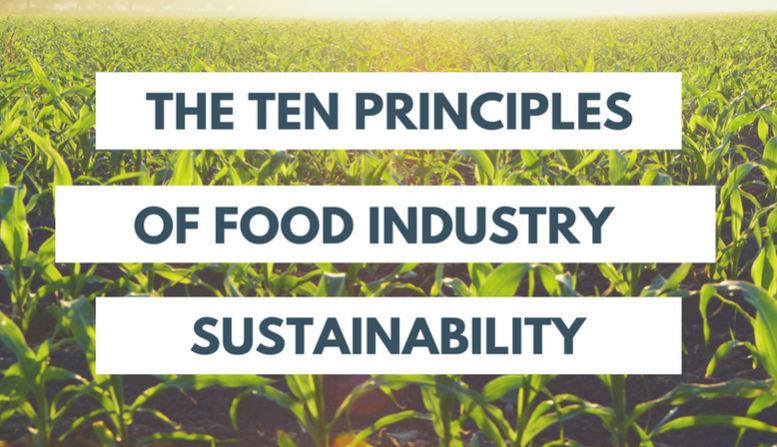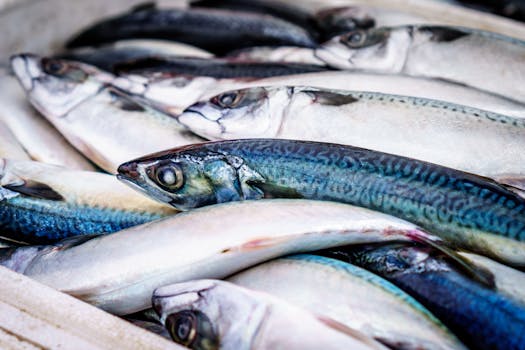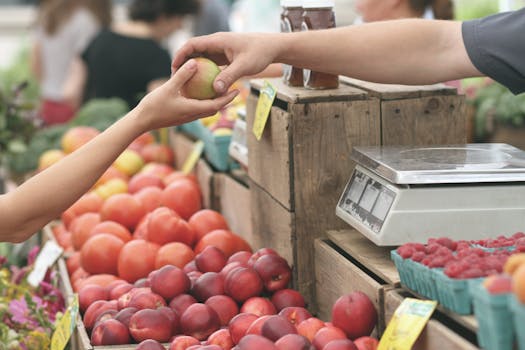The 10 Principles of Food Industry Sustainability
Last Updated on February 22, 2023
Last week on the blog we took a first hand look at what sustainability is and where the food industry needs to improve. We know that the food and beverage industry is making headway with its sustainability initiatives but it simply isn’t enough.
One of the problems with becoming more sustainable is the sheer number of directions you can take. Should a company first focus on food waste? Energy consumption? Sourcing? At the end of the day food companies are businesses and without a clear defined plan it is impossible for them to push forward with these initiatives.
This is where the “10 Principles of Food Industry Sustainability” come in. I came across these principles after learning about the “12 Principles of Green Chemistry” in one of my university classes. These food industry principles really resonated with me as I am a FoodGrad soon entering the industry.
The 10 Principles of Food Industry Sustainability are principles created by Cheryl Baldwin, Vice President of Consulting Pure Strategies. These principles are meant to inspire and inform food industry professionals to nourish the population, revitalize natural resources, enhance economic development and close resource loops. These principles can also be found in Cheryl Baldwin’s book of the same title. All of the information provided below can be found in her book.
Over the following weeks FoodGrads will explore each of these principles in depth, explaining what these principles mean and actions companies can take to provide scalable solutions which will be felt years to come! Let’s dive right into them!
1. Food Accessibility
Safe and highly nutritious food is accessible and affordable to promote and support a healthy population
This tenet simply states that we need to provide more safe and nutritious food that is accessible to the entire population. The purpose of our food system in general is to provide safe and nutritious food in order to support a healthy population. However, as a global nation we are failing because almost 807 million people around the world have too little to eat or are malnourished. It should be the food industries duty to provide not only safe food but also foods that are highly nutritious. Practices that would adhere to this principle are:
- Reduce fat, sugar and salt in processed foods
- Ensure diverse, healthy and nutritious food is available and affordable
- Avoid microbial, chemical and allergen contamination
2. Agriculture and the Environment
Agricultural production beneficially contributes to the environment while efficiently using natural resources and maintaining a healthy climate, land, water, and biodiversity
Agriculture is largest contributor to environmental degradation. Our food supply directly affects climate, biodiversity, water and pollution impacts. Even though some companies may not directly work with farmers their role in the food system still makes them a key player. This principle states that any positive role that a company takes in sustainability will directly affect the environment. If the correct choices are made than we avoid potential environmental damage and work to rebuild what was already lost. Practices that would adhere to this principle are:
-
- Source and support responsibly produced crops
- Implement responsible production techniques such as integrated pest management, crop rotations, cover crops/green cover and integrate conserved land
3. Welfare and Environmental Considerations
Use of animals, fish, and seafood in the food supply optimizes their well-being and adds to environmental health
This principle overlaps a bit with the last one listed but there is differentiation. With this principle it focuses on our reliance of ingredients and foods from animals, fish and seafood. Livestock is the major contributor of Green House Gas (GHG) production in the world. We need to focus our attention on the living conditions of our animals and how create positive contributions to the food system. Companies have reported that livestock treated at high welfare standards actually have more cost savings and provide a more secure supply. Overall, treat animals with respect. Practices that would adhere to this principle are:
-
- Diverse breed production for health, resilience and productivity
- Implement well-managed grazing/feeding and land stewardship
- Productive rearing that respects the five freedoms of responsible animal care
4. Processing
Food and ingredient processing generates resources and requires minimal additional inputs and outputs
Practically all food is processed by some sort of means. Yes, even that all natural product that only uses 5 ingredients. Cutting, washing, separating and other methods are sources of “processing.” This principle states that how we choose to process foods has a large impact on our carbon footprint. In the United States processing uses close to 20% of the total energy in the food cycle. Practices that would adhere to this principle are:
-
- Conserve, reuse and provide processing energy and water through, clean, and green processing
- Use renewable energy sources
5. Safe and Sustainable Working Conditions
Safe and suitable working conditions are provided to support employees across the supply chain
Fortunately, much of North America already adheres to this principle evident from the many Workplace Safety and Prevention Services. However, there is always room for improvement. This principle states that in addition to the food itself we should also be concerning ourselves with workers working conditions and livelihood. This includes how the workers are treated and paid. Practices that would adhere to this principle are:
- Respect human rights
- Provide fair wages and labour conditions
- Provide safe working conditions
6. Sourcing
Producer equity and rural economy and development are strengthened with fair and responsible production and sourcing
One of simplest ways for a company to become more sustainable is to source their materials for local sources. Not only does it diminish the amount of fuel needed to travel across terrains but helps to stimulate the local economy. This principle not only focuses on local sourcing but how and where you get your food can improve the lives of smallholders and women producers. Practices that would adhere to this principle are:
-
- Source from local communities
- Integrate diversity of sources into procurement
- Support smallholders and women in agriculture
7.Packaging
Packaging effectively protects food and supports the environment without damage and waste
Packaging is arguably the most important aspect when it comes to food. It is also the place were consumers are looking for solutions to the improving sustainability. Cheryl Baldwin states that packaging has its own life cycle with material, processing and end-of-life considerations. This principle states that we should be focusing on both how packaging is processed and its end-of-life processing. If properly analyzed than companies can actually have cost savings due to recycled content and less material. Practices that would adhere to this principle are:
-
- Optimize package’s functionality, materials and sourcing and end of life
- Support recycling
- Use materials that are able to compose
8. Food Waste
Food and ingredient waste and loss are prevented across the supply chain and what cannot be avoided is put to a positive use
One-third of food is lost or wasted world wide. If we combine this with the belief that by 2050 we will need to increase out food production by 60% than that is a big problem. Food wastage comes from individuals throwing out food that is still edible and food lost through processing. This principle states that we need to find novel ways to utilize our food waste and reduce the overall waste in general. Practices that would adhere to this principle are:
- Prioritize food wastage management to reduce, reuse and recycle/recover
9. Distribution and Channels
Food and ingredients are efficiently delivered across the supply chain and to the consumer
Although distribution and marketing channels may not be the leading sources in sustainability challenges it is still something that we need to consider. Companies not only need to know how to get the products to the customer but also how their ingredients get to the company themselves. This principle simply states that how goods are transported will improve the overall supply chain efficiency. Furthermore, we need to consider more way to efficiently transport foods to “food deserts.” Practices that would adhere to this principle are:
-
- Distribute efficiently and conserve fuel through lower GHG-emitting modes, route changes and alternative fuels
- Conserve, reuse and provide energy and water through maintenance and efficient technology
- Purchase environmentally preferable products and services
10. Consumers
The supply chain and consumers advance sustainable business and food consumption
It is not only food companies that we need to consider when becoming more sustainable. The industry also needs to consider consumers as well because their decisions dictate what food manufactures do. Consumer interest in sustainability continues to grow. In the United States,70% of consumers are seeking out more sustainable products. We need to ensure that interest does not waver and sustainability becomes a norm. The principle simply means that we need to educate and push consumers to become more sustainable through their diets and food waste methods. Practices that would adhere to this principle are:
- Optimize consumer’s eating by shifting diets to more plant-based and fresh foods
- Educate consumers on food waste strategies
- Support consumer in other areas of impact
Author: Veronica Hislop Veronica is a Chemistry student studying at Ryerson University and loves looking at the science in the kitchen. She has a passion for bringing awareness to sustainability in the food industry. When Veronica is taking a break from her food endeavors you will find her at home reading a great novel and playing with her cats.
Subscribe to our newsletter for details on mentorship sessions, workshops, webinars, as well as career and job fairs across Canada and the US!





leave your comment